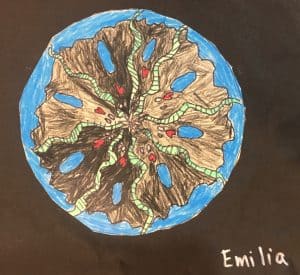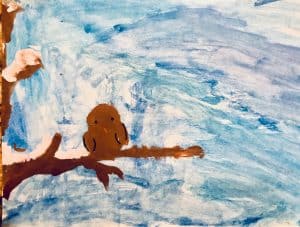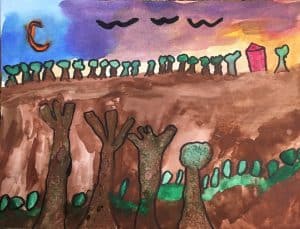
Here at the end of the school year and beginning of summer, children everywhere are coming home with backpacks, binders, and folders full of an entire year’s worth of their artwork and creative output. To the kids and many of their doting parents, every work is a masterpiece to be savored and saved. After all, what if they become famous artists one day? OK, let’s stop right there. If you’re serious about curating your children’s artwork and creating a manageable archive of their school years, the following tips should provide a guilt-free guide to get you started.
Kinderkunst is not part of a catalogue raisonné. While it’s true that Pablo Picasso showed artistic talent at an early age, it is unlikely that any of his preschool pieces were instrumental in getting him accepted into the Spanish Royal Academy. If your child shows a talent for visual art (or music, dance, literature, etc.) concentrate less of your effort on preserving their earliest works, and more on encouraging their interest. Visit the art museum or a local gallery to see works from other artists on the walls. Talk about how artists made the pieces. What were they thinking and trying to say? Sign your child up for classes at the local museum or arts center, so they can continue to learn and grow in their creative expression.
It’s OK to cull. No one can be expected to keep everything ever created by everyone they care about. Imagine if your mother kept every story, sketch, painting, poem, and project you produced from preschool through high school. Would you want it all now? Really?? Maybe your mom did keep it all and it’s all waiting at her house for you to sort through and take it home with you. Yikes! Let’s apply that feeling of dread to the process of culling what comes home with your kids and spare them that process.
 Keep only half as many items as they are old. Let’s face it, toddler artwork is great when hanging en masse in a preschool hallway, but individually they are really just expressions of a developmental period of time in your child’s life. As kids grow up the thoughts and feelings they put into their creative expressions become more about who they are than merely what age they are, so you can keep more meaningful examples. If you save only three things from your six-year-old’s first grade year (for instance, one writing sample and two artworks), then you may have room to save twice as many when she’s twelve, a time when her work is likely to say much more about the personal transitions she experienced that seventh grade year.
Keep only half as many items as they are old. Let’s face it, toddler artwork is great when hanging en masse in a preschool hallway, but individually they are really just expressions of a developmental period of time in your child’s life. As kids grow up the thoughts and feelings they put into their creative expressions become more about who they are than merely what age they are, so you can keep more meaningful examples. If you save only three things from your six-year-old’s first grade year (for instance, one writing sample and two artworks), then you may have room to save twice as many when she’s twelve, a time when her work is likely to say much more about the personal transitions she experienced that seventh grade year.
 Do you like it? This is the essential rule of collecting anything. Don’t keep it because you think it might be worth something someday, save because it speaks to you. Look at the piece– really look at it. Does it make you smile? It doesn’t have to spark joy, but it should be a memorable reminder of your child’s growth in school. Take photos of pieces you like, but don’t have the space to keep, and use them as wallpaper on your phone, or a screensaver on your computer at work.
Do you like it? This is the essential rule of collecting anything. Don’t keep it because you think it might be worth something someday, save because it speaks to you. Look at the piece– really look at it. Does it make you smile? It doesn’t have to spark joy, but it should be a memorable reminder of your child’s growth in school. Take photos of pieces you like, but don’t have the space to keep, and use them as wallpaper on your phone, or a screensaver on your computer at work.
Take notes. The years fly by unimaginably fast and it will soon become impossible to remember which child made which work in which year. Do yourself a favor; write the child’s name, grade, and the year in pencil on the back of each piece.
 To archive, or not to archive? That is a good question. Having worked for 25 years in museums and heritage preservation, and also being a mother of two school-age children, I have mixed feelings here. On the one hand, if you truly want to preserve paper materials for posterity, then you need to store them in an inert, archival environment. Right, but we’re talking about elementary arts and literature, is it really worth the acid-free box? I will leave that decision up to you. Here is a link to the Gaylord Archival website, if you would like to purchase those special materials.
To archive, or not to archive? That is a good question. Having worked for 25 years in museums and heritage preservation, and also being a mother of two school-age children, I have mixed feelings here. On the one hand, if you truly want to preserve paper materials for posterity, then you need to store them in an inert, archival environment. Right, but we’re talking about elementary arts and literature, is it really worth the acid-free box? I will leave that decision up to you. Here is a link to the Gaylord Archival website, if you would like to purchase those special materials.
 I choose not to put my kids’ artwork, school and sports certificates, writing assignments, and annual accolades in archival-quality boxes. I’m short on storage space, so I purchased three decorative paper boxes (a large one for each child and a smaller shared one for their collected medals, baubles, and knickknacks), which are stacked up and sitting out in our guest room. The girls have easy access to their boxes and put things in periodically under my direction. One rainy day each summer, I open the boxes to sift through what accumulated throughout the past year. I write their age and teacher’s name on the back of anything missing that information, straighten out the stack, smile at the unrelenting passage of time, wipe my eyes, and close up the boxes again.
I choose not to put my kids’ artwork, school and sports certificates, writing assignments, and annual accolades in archival-quality boxes. I’m short on storage space, so I purchased three decorative paper boxes (a large one for each child and a smaller shared one for their collected medals, baubles, and knickknacks), which are stacked up and sitting out in our guest room. The girls have easy access to their boxes and put things in periodically under my direction. One rainy day each summer, I open the boxes to sift through what accumulated throughout the past year. I write their age and teacher’s name on the back of anything missing that information, straighten out the stack, smile at the unrelenting passage of time, wipe my eyes, and close up the boxes again.
 You’re the boss, own it! Ultimately, what you keep and how you keep it is entirely up to you. You are entitled to make practical decisions based on the quality and quantity of stuff presented to you at the end of every year. Pinterest is full of ideas for fun summer boredom-breakers that involve recycling, upcycling, and repurposing some of their projects. I have collected a few of my favorites on my Upcycling board and am happy to share, but don’t feel guilty if you just end up tossing them out. You and I both know, there will be plenty more coming home next year.
You’re the boss, own it! Ultimately, what you keep and how you keep it is entirely up to you. You are entitled to make practical decisions based on the quality and quantity of stuff presented to you at the end of every year. Pinterest is full of ideas for fun summer boredom-breakers that involve recycling, upcycling, and repurposing some of their projects. I have collected a few of my favorites on my Upcycling board and am happy to share, but don’t feel guilty if you just end up tossing them out. You and I both know, there will be plenty more coming home next year.



